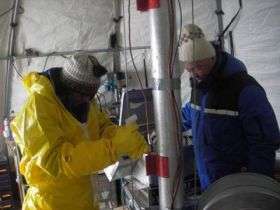Ice cores map dynamics of sudden climate changes

New, extremely detailed data from investigations of ice cores from Greenland show that the climate shifted very suddenly and changed fundamentally during quite few years when the ice age ended. Researchers from the Niels Bohr Institute of University of Copenhagen have together with an international team analysed the ice cores from the NorthGRIP drilling through the Greenland ice cap, and the epoch-making new results have been published in the highly esteemed scientific journal Science and in Science Express.
The ice in Greenland has been formed by snow that stays year after year and is gradually compressed into a thick ice cap. The annual layers inform us about the climate during the years when the snow was falling so the ice is a record of the climate of the past, and ice core drillings through the three km thick ice cap show the climate 125,000 years back in time.
In the Northern Hemisphere the last glacial ended in strong variations of temperature, which consisted of two warming periods interrupted by a cold period. The first sudden warming happened 14,700 years ago. The temperature in Greenland increased by more than 10 degrees, and in the milder climate, called the Bølling period, the first people of the Stone Age went towards Northern Europe and Scandinavia. But joy did not last long. 12,900 years ago the ice age stroke once more with a new severely cold period, which lasted until 11,700 years ago, at which time the ice age ended ultimately. The ice cores from Greenland, which reflect the climate in the Northern Hemisphere, show that tremendously fast climatic changes were involved.
The ice age ended in one year
"We have analysed the transition from the last glacial till our present warm interglacial period, and the climatic shifts are happening so suddenly as if somebody had pushed a button", says Dorthe Dahl-Jensen, Professor at the Centre for Ice and Climate at the Niels Bohr Institute of the University of Copenhagen.
The new data from the ice cores show that the climate shifted from one year to the next. The annual layers of the ice have been analysed in a very high resolution for a number of components that in their own way tell us about the climate.
Dust. The amount of dust has been measured. The colder the climate is, the more dust is available in the atmosphere of the Earth, and the more dust is blowing over the land settling on the ice cap.
Oxygen. The amount of the special oxygen-isotope O-18 has been measured, and tells about the temperature where the atmospheric precipitation is formed. The higher the content of the oxygen-isotope O-18, the warmer is the climate locally in the place of atmospheric precipitation.
Hydrogen. Also the amount of the special hydrogen-isotope deuterium has been measured. Excess of deuterium reflects the temperature at the places where the precipitation vapour originally comes from. The air masses are circulating around the earth, and the greater excess of deuterium, the warmer was the climate in the original area.
By comparing the content of dust, oxygen and hydrogen in the annual layers of the ice cores the researchers can now investigate how a climatic shift develops year by year.
At first the dust content begins to change and decreases to one tenth over some decades. As the dust in the ice derives from Asia the researchers conclude that there have been climatic changes far from Greenland.
"Some years later the atmospheric precipitation starts to change. Our measurements show that the excess of deuterium in relation to O-18 changes in quite few years. This means that the vapour coming to Greenland changes source areas. The conclusion is that extremely fast and dramatical changes of the weather systems have taken place over the Atlantic", says Sune Olander Rasmussen, ice core researcher at the Centre for Ice and Climate at the Niels Bohr Institute.
The new results help mapping out how climatic shifts happen, and which climatic processes are the most important during these changes.
"Even though the climatic changes at the end of the ice age are seen most violently in the Northern Atlantic regions our measurements suggest that they are initiated by changes in the tropical areas. We can also see that when abrupt climate change is going on, it is the atmospheric circulation that has changed fundamentally", concludes Dorthe Dahl-Jensen.
The new information about the climate of the past is important knowledge for the improvement of the climate models used for predicting the climate of the future.
Source: University of Copenhagen

















